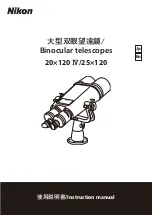
27
EN
3. Telescope ABC’s
What do the following terms mean?
Barlow Lens:
The Barlow Lens was named after its inventor,
Peter Barlow, a British mathematician and phy-
sicist who lived from 1776-1862. The lens can
be used to increase the focal width of a tele-
scope. Depending on the type of lens, it is pos-
sible to double or even to triple the focal width.
As a result, the magnification can of course also
be increased. See also “Eyepiece.“
Focal width:
Everything that magnifies an object via an op
-
tic (lens) has a certain focal width. The focal
width is the length of the path the light travels
from the surface of the lens to its focal point.
The focal point is also referred to as the focus.
In focus, the image is clear. In the case of a te-
lescope, the focal widths of the telescope tube
and the eyepieces are combined:
Lens:
The lens turns the light which falls on it around
in such a way so that the light gives a clear
image in the focal point after it has traveled a
certain distance (focal width).
Eyepiece:
An eyepiece is a system made for your eye and
comprised of one or more lenses. In an eyepie-
ce, the clear image that is generated in the focal
point of a lens is captured and magnified still
more.
There is a simple formula for calculating the
magnification:
Focal width of the telescope tube / Focal width
of the eyepiece = Magnification
You see: In a telescope, the magnification de
-
pends on both the focal width of the telescope
tube and the focal width of the eyepiece.
From this formula, we see that if you use an
eyepiece with a focal width of 20 mm and a te-
lescope tube with a focal width of 600 mm, you
will get the following magnification:
600 mm / 20 mm = 30 times magnification
Inverting lens:
The inverting lens is set into the eyepiece holder
of the telescope before the eyepiece itself. This
lens can produce an additional magnification
(mostly around 1.5x) via the integrated lens in
the eyepiece. As the name suggests, the image
will be turned around if you use an inverting
lens, and appears upright and even properly ori-
ented on the vertical axis.
Magnification:
The magnification corresponds to the difference
between observation with the naked eye and
observation through a magnification apparatus
(e.g. a telescope). In this scheme, observation
with the eye is considered “single”, or 1x magni-
fication. Accordingly, if a telescope has a mag
-
nification of 30x, then an object viewed through
the telescope will appear 30 times larger than it
would with the naked eye. See also “Eyepiece.“
Zenith mirror:
A mirror that deflects the ray of light 90 de
-
grees. With a horizontal telescope tube, this
device deflects the light upwards so that you
can comfortably observe by looking downwards
into the eyepiece. The image in a zenith mirror
appears upright, but rotated around its vertical
axis (what is left appears right and vice versa).
Summary of Contents for 70/900 EL
Page 3: ...b C D F G H I J 1 1 1 1 1 1 1 b 1 1 1 1 I 1 d E 2 1 1 2 c c ...
Page 99: ...99 CZ ...
Page 111: ...111 HR ...
Page 123: ...123 PL ...
Page 135: ...135 SK ...
Page 147: ...147 RO ...
Page 159: ...159 BG ...
Page 171: ...171 RU ...














































